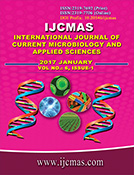


 National Academy of Agricultural Sciences (NAAS)
National Academy of Agricultural Sciences (NAAS)

|
PRINT ISSN : 2319-7692
Online ISSN : 2319-7706 Issues : 12 per year Publisher : Excellent Publishers Email : editorijcmas@gmail.com / submit@ijcmas.com Editor-in-chief: Dr.M.Prakash Index Copernicus ICV 2018: 95.39 NAAS RATING 2020: 5.38 |
This study aimed to determine bacteriological quality of indoor air in neonatal wards at tertiary hospitals and assess antibiotic resistance patterns of isolated bacteria. Passive air sampling was performed to appraise bacteriological indoor air quality employing the gravity settle plate method to monitor air quality in the morning and afternoon. Each procedure was performed in duplicate on Nutrient Agar plates for 30 and 60 minutes. A total of 75 bacteria were isolated and subjected to antibiotic sensitivity tests using the Kirby-Bauer’s disk diffusion method. Staphylococcus aureus, Klebsiella pneumonia, Pseudomonas aeruginosa and Escherichia coli were the frequently isolated airborne bacteria. Staphylococcus species was predominant (49.3%) and 6% was E. coli. The bacterial counts ranged from 19-383 cfu/plate, which was higher in the afternoon than morning. Most of the tested bacteria were sensitive to imipenem but resistant to ampicillin and ceftriaxone. Eighty percent of the bacteria were resistant to commonly used antibiotics. The fact that, the airborne bacterial counts were higher in the afternoon could be attributed to higher human influx and increased activities. Rigorous hygienic measures and observance of standard operating procedures are recommended to improve the microbiological indoor air quality and thus prevent potential infections by antibiotic resistant airborne bacteria.
 |
 |
 |
 |
 |